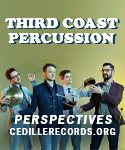The title of the CD (and contrary to the two-disc jewel-box packaging, this is only a single CD) comes from a lauda by early-16th century composer Bartolomeo Tromboncino. It’s sung by tenor Julian Podger with exceptional tonal beauty and lyric expression–an ideal match of vocal character with poetic text. In fact, Podger proves to be the star of this program, a singer who makes such lovely music you don’t even care what he’s singing, although in this case it’s both solo songs with lute accompaniment and, as part of a vocal quartet, several memorably tuneful and harmonically colorful a cappella selections. The programming concept celebrates the Italian Renaissance traditions exemplified by singer/poets whose repertoire was not written but rather was composed, improvised, altered, adapted, and transformed into innumerable versions, which were then borrowed and passed on by other musicians, only to be changed–perhaps elaborated, perhaps simplified–by later singers.
This fluid and very immediate manner of composing and performing was well understood and appreciated by audiences, especially since the texts often were taken from the vernacular and concerned topics familiar to everyone. Eventually, tunes were more commonly written–along with accompaniments and additional parts, which may have been either sung or performed on viols or other instruments. Frottola, which grew out of the practices of the improvising songwriters and singers, were multi-part songs that could be regarded as precursors of the madrigal. These pieces tend to be characterized by strong rhythms and prominent melodies; the laude are devotional songs with sacred texts. Both of these forms are represented here in works by some of the genres’ more distinguished composers, especially Marchetto Cara and the above-mentioned Tromboncino.
Several solo songs are performed by soprano Carolyn Sampson (accompanied by lutenist Robert Meunier), and her clear-focused, golden-toned voice makes a fine complement to Podger’s. Like Podger she takes the texts seriously and understands how important the melodic contours and dynamics are to the overall interpretive effect. And no question, there are some really beautiful songs here–I kept noticing that the more impressive ones were by Cara, including one I couldn’t get out of my head, Aimè, ch’io moro, which appears here for the first time in its vocal ensemble incarnation. Some songs begin with the promise of enduring appeal, but then just go on too long, undermining our concentrated interest. The anonymous Pavana, featuring Meunier and fellow lute-player Guy Ross, is one such interminable and musically uninspiring piece whose less-than-exciting qualities are only underlined by Ross’ surprisingly shaky technique. The sound, made in a Cambridge, England church, is excellent–vibrant, clear, and particularly kind to the vocal timbres and balances. This certainly isn’t the kind of repertoire that flies out of the record store, but with production values this high and songs of this quality it should find a welcome and oft-visited home in the CD library of any fan of Renaissance vocal music.
































